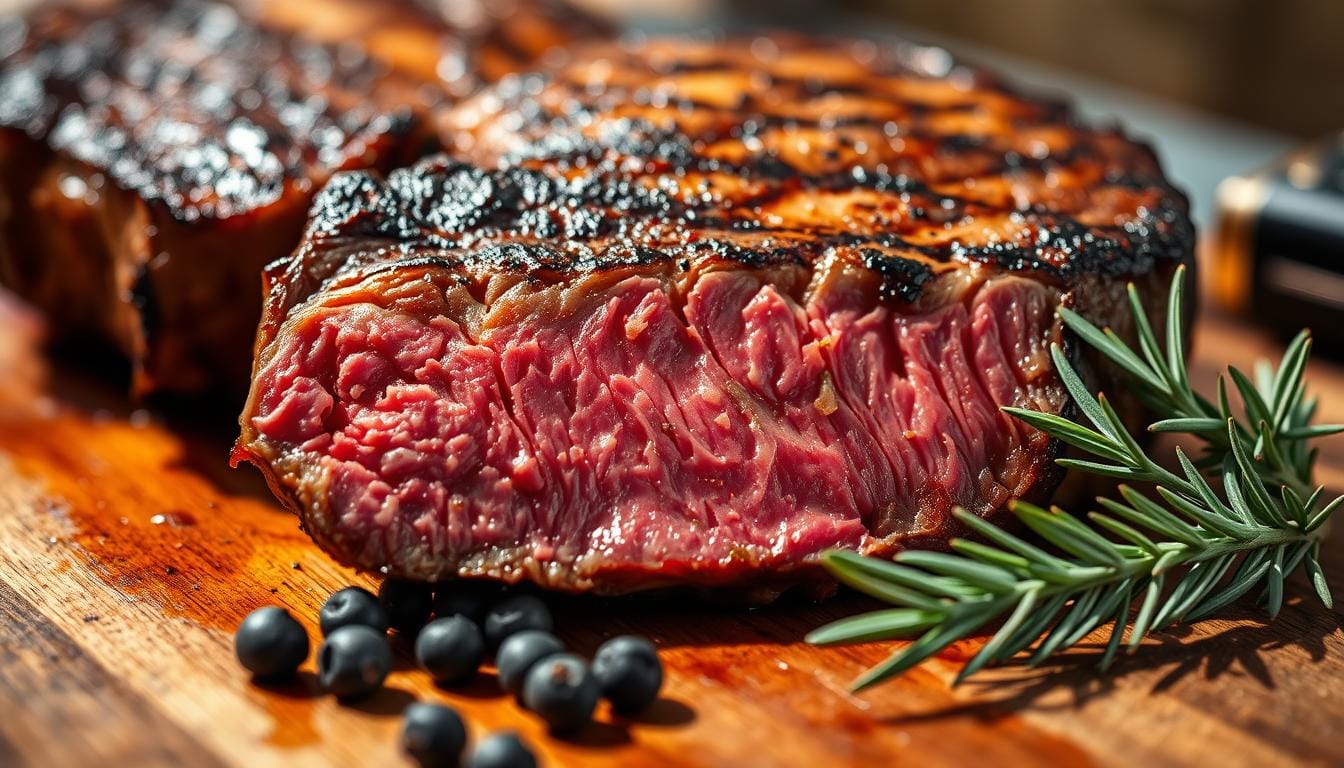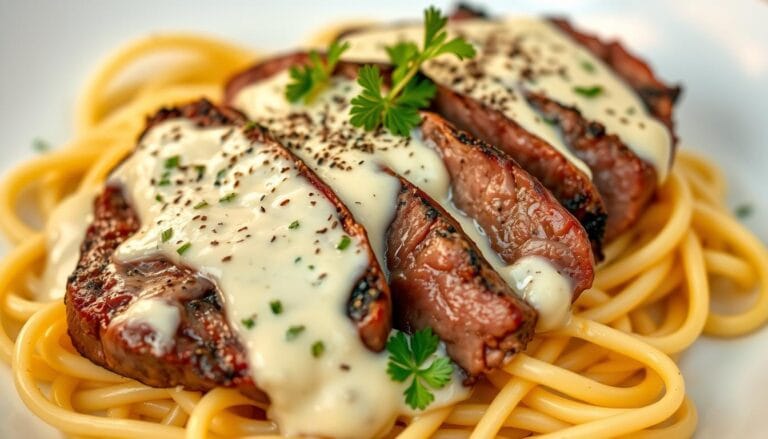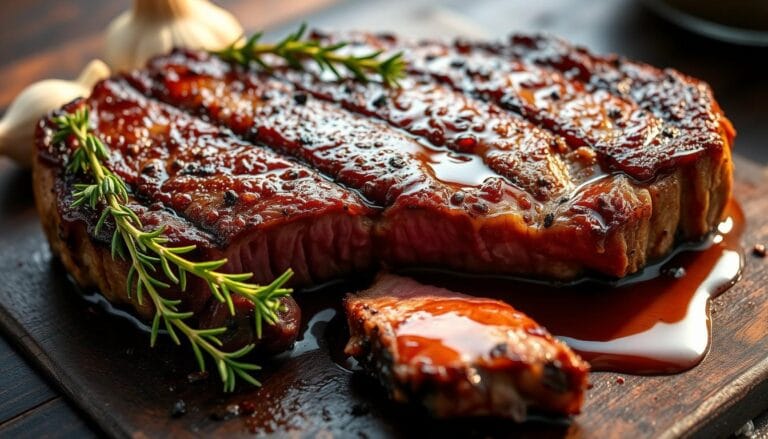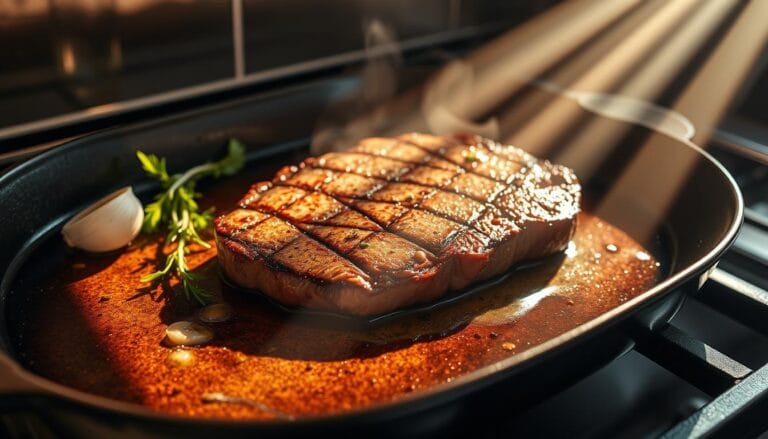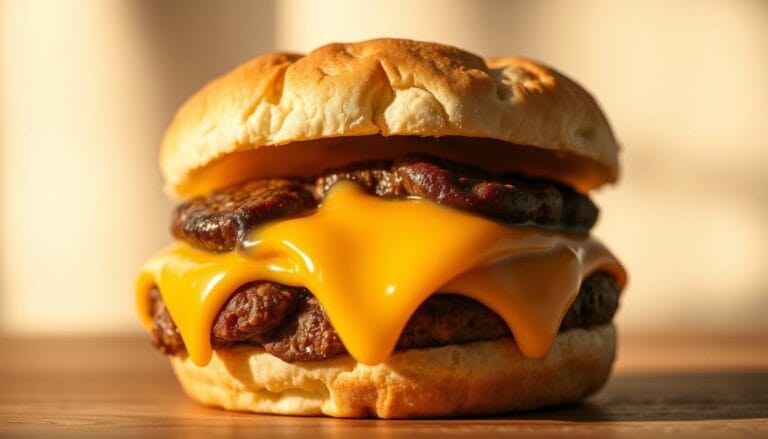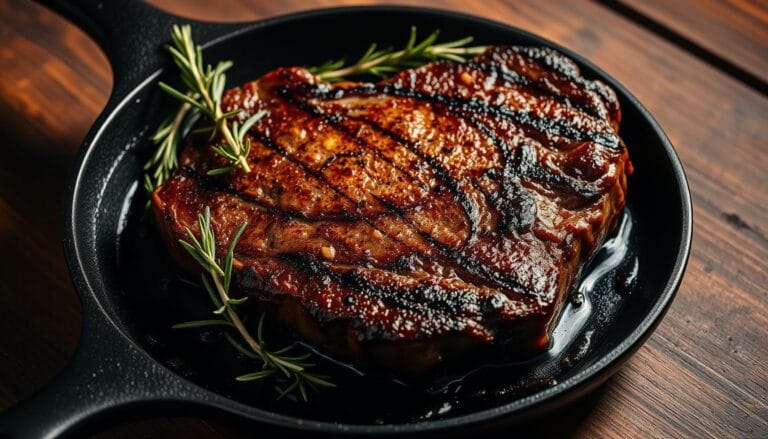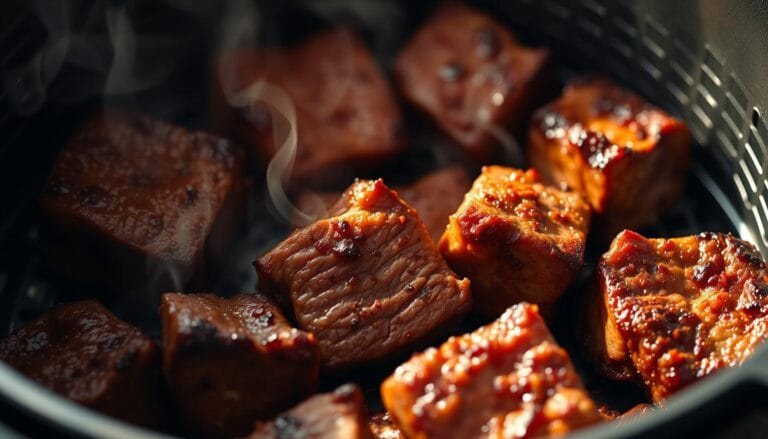Your Guide to Cooking the Perfect Denver Cut Steak
Table of Contents
Your Guide to Cooking the Perfect Denver Cut Steak
Cooking the perfect Denver Cut Steak is a dream for many steak lovers. Imagine biting into a tender, juicy steak, with flavors bursting in your mouth. To achieve this, you need to know the special qualities of this cut and how to cook it just right.
So, what’s so special about a Denver Steak? It’s known for its rich taste and tender feel, perfect for any meal. With the right tips, you can impress everyone with a deliciously cooked steak.
Key Takeaways
- Understand the unique qualities of the Denver Cut Steak.
- Learn how to select the best quality meat.
- Discover various cooking techniques to enhance flavor and texture.
- Master the art of preparing a perfect Denver Cut Steak.
- Impress your family and friends with your culinary skills.
Introduction to Denver Cut Steak
For those new to the Denver cut steak, it’s a favorite for its rich taste and tender feel.
The Denver cut steak, also known as the Denver steak cut, comes from the cow’s chuck or shoulder area. Despite being from a tougher section, it’s surprisingly tender. This is thanks to its unique muscle structure.
This cut has quickly become a hit among steak lovers. It’s known for its exceptional tenderness and rich flavor. The Denver cut’s location on the beef carcass adds to its marbling. This makes it taste even better when cooked.
The Denver cut steak is a newer addition to the culinary world. It’s now found in butcher shops and restaurants across the U.S. Its growing popularity shows its quality and the great dining experience it offers.
Learning about the Denver cut steak is the first step to enjoying it. Whether you’re a pro chef or a home cook looking to try new things, this cut is worth checking out. It’s versatile and full of flavor.
What Makes Denver Cut Steak Unique?
The Denver cut steak is special because of its rich history and top-notch quality. It’s a favorite among steak lovers. Its unique origin adds to its charm.
The Origin of the Denver Cut
The Denver cut was found in the early 2000s through the Beef Checkoff Program. Before, it was part of big chuck roasts. But, when cut right, it’s tender and tasty.
This cut comes from the serratus ventralis muscle. It’s known for being tender and flavorful. Its story shows how the beef industry is always looking to improve.
Flavor Profile of the Denver Cut
The Denver cut steak is famous for its deep, beefy taste. This comes from its good marbling. The fat makes it juicy and flavorful.
Chefs and steak fans love it for its mix of tenderness and taste. It’s tender and tasty, yet cheaper than some premium cuts. This makes it a top pick for many.
Selecting the Right Denver Cut Steak
Choosing the right Denver cut steak is more than just picking any meat. It needs knowledge and detail. Knowing what to look for is key to great cooking.
Tips for Shopping at the Butcher
Shopping at a local butcher is a great idea for a Denver cut steak. Butchers offer a variety of cuts and valuable insights. Building a relationship with your butcher helps find the perfect cut for you.
Butchers know the Denver cut steak by different names, like “underblade steak” or “chuck under blade center.” Knowing these names helps ensure you get what you want.
Having a good relationship with your butcher has many benefits. They can provide high-quality Denver cut steaks and give personalized advice. Ask about the meat’s origin, aging, and best cooking methods.
Choosing Quality Meat
Quality Denver cut steak has several key features. Look for marbling, the white flecks of fat, for tenderness and flavor. A bright red color means the meat is fresh.
The steak’s thickness is also important. Aim for 1 to 1.5 inches thick. This thickness ensures a great char on the outside and the right doneness inside.
Knowing the grades of beef is vital. Beef is graded as Prime, Choice, or Select, with Prime being the highest. While Prime steaks are the best, Choice can offer a good balance of quality and price. Knowing these grades helps you make a better choice.
Essential Tools for Cooking Denver Cut Steak
Cooking the perfect Denver cut steak needs more than a good recipe. It requires the right tools. The quality of your cookware and kitchen gadgets can make a big difference. It can turn a good steak into a great one.
Must-Have Kitchen Gadgets
You’ll need some essential kitchen gadgets to start. A reliable meat thermometer is key for the perfect doneness. You won’t need to cut into the steak, keeping the juices in.
Other must-haves include sharp knives. You’ll need a good chef’s knife for prep and a slicing knife for serving. Also, quality tongs for handling the meat without piercing it. And don’t forget a timer to keep track of cooking times.
Recommended Cookware
The cookware you choose can greatly affect cooking. Cast iron skillets are highly recommended. They retain and distribute heat well, helping to achieve a perfect sear.
But, other options like carbon steel pans, grill pans, and outdoor grilling equipment are also good. Each has its own benefits.
| Cookware Type | Heat Retention | Ease of Use |
|---|---|---|
| Cast Iron Skillet | Excellent | Moderate |
| Carbon Steel Pan | Very Good | Easy |
| Grill Pan | Good | Easy |
| Outdoor Grilling Equipment | Excellent | Moderate |
With these essential tools, you’ll be ready to cook a Denver cut steak that will impress everyone.
Preparing Your Denver Cut Steak
Now that you’ve picked the perfect Denver cut steak, it’s time to get it ready for cooking. The right preparation is key to bringing out the steak’s best flavors.
Proper Thawing Techniques
If your Denver cut steak is frozen, thawing it safely is the first step. The best way is to thaw it slowly in the fridge. This takes about 24 hours for a 1-inch steak. It keeps the steak safe and of high quality.
For quicker thawing, you can use cold water. Place the steak in cold water and change the water every 30 minutes. Avoid thawing at room temperature or in the microwave, as these can harm the steak’s quality.
Seasoning for Maximum Flavor
Seasoning is vital for boosting your Denver cut steak‘s flavor. Begin with salt and pepper. Salting the steak ahead of time can greatly enhance its taste. You can also try herbs and spices that complement this cut.
Some chefs like to keep it simple, letting the steak’s natural taste shine. Others prefer more complex seasonings. Choose what you like, but respect the Denver cut steak‘s unique qualities.
- Use a mix of garlic powder, paprika, and thyme for a savory taste.
- Try chili powder and cumin for a spicy flavor.
- Keep it simple with salt, pepper, and a squeeze of lemon juice.
Cooking Methods for Denver Cut Steak
The Denver Cut Steak is loved for its marbling. This makes it great for many cooking styles. You can try different ways to cook it and see what you like best.
There are several ways to cook a Denver Cut Steak. Each method gives a unique taste. You can grill, sear on the stovetop, or slow cook it. Knowing how to do each method well is key to making a perfect steak.
Grilling the Perfect Denver Cut
Grilling adds a smoky taste and a nice char to the steak. First, heat your grill to medium-high. Then, watch the temperature and cooking time to get it just right.
Here’s how to grill your Denver Cut Steak:
- Preheat the grill to medium-high heat.
- Season the steak as you like.
- Cook for 4-5 minutes per side, until it’s done to your liking.
- Let it rest for a few minutes before you serve it.
Grill master Steven Raichlen says, “The secret to a great grilled steak is the heat, timing, and meat quality.”
“A great steak is all about the balance of flavor, texture, and presentation.”
Searing on the Stovetop
Searing on the stovetop gives a crusty edge to your steak. Start by letting the steak come to room temperature and drying it. Heat a skillet over high, add oil, and sear the steak for 2-3 minutes on each side.
| Cooking Time | Doneness Level |
|---|---|
| 2-3 minutes per side | Rare |
| 4-5 minutes per side | Medium Rare |
| 6-7 minutes per side | Medium |
Slow Cooking Techniques
Slow cooking makes the steak tender and soft. Methods like reverse searing and sous vide cooking work well. Reverse searing cooks the steak in the oven first, then sears it quickly on the stovetop.
Sous vide cooking seals the steak in a bag and cooks it in water at a set temperature. This keeps the steak evenly cooked.
Trying different cooking methods can help you find your favorite way to enjoy a Denver Cut Steak. Whether you like the char from grilling, the crust from searing, or the tenderness from slow cooking, this steak is sure to please.
Understanding Denver Cut Steak Doneness
To enjoy a Denver cut steak fully, knowing its doneness is key. The doneness of a steak affects its taste and texture. It’s what makes a steak great.
Using a Meat Thermometer
A meat thermometer is vital for perfect doneness. There are many types, like digital and wireless thermometers. They all help you get the steak’s internal temperature right.
To use a thermometer, put the probe in the steak’s thickest part. Avoid fat and bone. For digital thermometers, wait for the reading to settle. Here are the temperature targets for different doneness levels:
- Rare: 125°F
- Medium-rare: 135°F
- Medium: 145°F
- Medium-well: 150°F
- Well-done: 160°F
Remember, the steak will cook a bit more after it’s off the heat. So, take it off when it’s 5-10°F below your target.
Color Guide for Doneness Levels
Without a thermometer, you can guess the doneness by color and feel. Here’s a quick guide:
- Rare: The steak will have a deep red center and feel soft.
- Medium-rare: The center will be warm red, and the steak will feel firmer.
- Medium: A hint of pink will remain in the center, and the steak will feel springy.
- Medium-well: Only a slight hint of pink will be visible, and the steak will feel firmer.
- Well-done: The steak will be fully cooked with no pink color remaining, feeling hard to the touch.
While thermometers are the most accurate, knowing visual cues helps too. Whether you like your steak rare or well-done, these tips will improve your cooking.
Resting and Slicing Your Denver Cut Steak
Serving a great Denver cut steak starts with resting and slicing right. After cooking your steak to the perfect doneness, let it rest before slicing.
Importance of Resting
Resting your Denver cut steak is key. It lets the juices spread evenly, making each bite juicy and tender. When you cook a steak, the heat pushes juices to the surface.
By resting, you let these juices spread back into the meat. This makes your steak more enjoyable to eat.
For resting, let the steak sit for about 5 minutes per inch of thickness. To keep the heat in, cover it with foil. This helps keep the crust you worked hard to get.
| Steak Thickness | Resting Time |
|---|---|
| 1 inch | 5 minutes |
| 1.5 inches | 7-8 minutes |
| 2 inches | 10 minutes |
How to Slice for Optimal Tenderness
Slicing your Denver cut steak against the grain is key for tenderness. The Denver cut has a special muscle pattern. Cutting across these fibers makes each bite softer.
To slice right, first find the grain’s direction by looking at the steak’s surface. Then, use a sharp knife to cut about ¼ to ½ inch thick. A sharp knife makes slicing easier and prevents the meat from tearing.
How you present your Denver cut steak matters too. Whether plating individual portions or serving family-style, your slicing and arrangement can make a big difference.
Serving Suggestions for Denver Cut Steak
The right side dishes and wine pairings can make your Denver cut steak unforgettable. The choices you make can either enhance or overwhelm its flavor. Here, you’ll learn how to pick the perfect sides and drinks.
Side Dishes That Pair Well
Choosing the right sides is key for a great meal. Classic options like roasted potatoes and grilled vegetables offer a nice contrast to the steak. For a bold taste, try blue cheese polenta or mushroom risotto for their rich flavors.
Other creative options include:
- Chimichurri roasted vegetables for a fresh taste
- Garlic mashed potatoes for a comforting side
- Roasted root vegetables for a hearty, earthy flavor
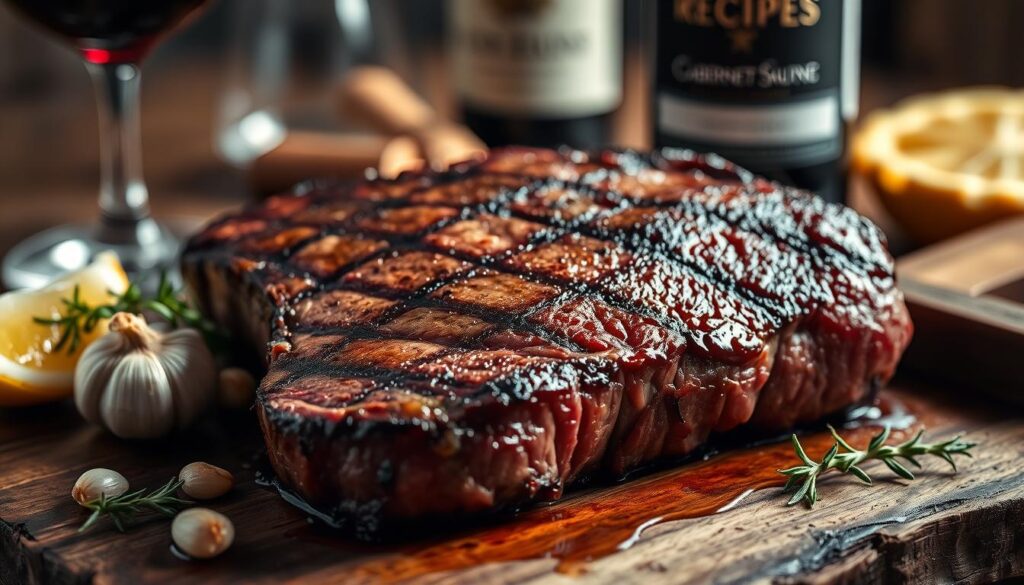
Wine Pairings to Enhance Flavor
The right wine can boost your Denver cut steak’s flavors. Medium to full-bodied red wines work best because of their tannins and flavor notes. Try Cabernet Sauvignon, Malbec, or Syrah for a great match.
If you prefer not to drink wine, craft beers like amber ales or porters can also pair well. Or, choose non-alcoholic options based on your taste.
Denver Cut Steak Marinades and Rubs
To make your Denver cut steak taste better, try marinades and rubs. Marinades are liquids that add moisture and flavor. Rubs are dry mixes that create a tasty crust.
Simple Marinade Recipes
Marinades can be simple. Mix olive oil, garlic, and herbs. A classic mix includes olive oil, minced garlic, rosemary, salt, and pepper.
To make a marinade, mix 1/2 cup olive oil, 2 cloves garlic, 2 tablespoons rosemary, 1 teaspoon salt, and 1/2 teaspoon black pepper. Put your steak in a bag, add the marinade, and chill for 2 to 4 hours.
Spice Rub Combinations
Spice rubs give your steak a deep flavor. A basic rub has salt, pepper, and spices.
For a simple rub, blend 2 tablespoons kosher salt, 1 tablespoon black pepper, 1 tablespoon paprika, and 1 tablespoon brown sugar. Rub it all over the steak, making sure it’s coated well.
| Flavor Profile | Marinade/Rub | Main Ingredients |
|---|---|---|
| Classic | Marinade | Olive oil, garlic, rosemary |
| Spicy | Rub | Chili powder, cumin, smoked paprika |
| Asian-Inspired | Marinade | Soy sauce, ginger, garlic |
Common Mistakes to Avoid
To enjoy a delicious Denver cut steak, avoid common cooking errors. Even skilled cooks can make mistakes that ruin the steak. Knowing these mistakes helps you cook a perfect Denver cut steak every time.
Overcooking Your Steak
Overcooking is a big mistake with Denver cut steak. This cut can become tough and lose flavor if cooked too long. Signs of overcooking include a firm steak and shrinkage.
To avoid overcooking, take the steak off heat before it reaches the target temperature. This is called carryover cooking. A meat thermometer helps you get the perfect doneness.
Other tips include not pressing down on the steak and not cooking it over high heat for too long. Letting the steak rest after cooking helps the juices redistribute.
- Monitor the steak’s temperature closely.
- Don’t overcrowd the cooking surface.
- Use a thermometer to check for doneness.
Skipping the Resting Step
Skipping the resting step is another mistake that can make your steak less enjoyable. Cutting into a steak right after cooking lets the juices flow out, making it dry. Resting the steak allows the juices to redistribute, making it tender and flavorful.
Chef Gordon Ramsay said, “You can’t just cook a steak and serve it. You need to let it rest, so the juices can redistribute.”
To make the most of resting, plan your meal components ahead. Serve side dishes while the steak rests. This simple step greatly improves your Denver cut steak.
Other mistakes to avoid include starting with cold meat, seasoning at the wrong time, and constantly flipping or moving the steak. Also, using the wrong heat level is a mistake. By knowing these common pitfalls, you can avoid them and always get great results with your Denver cut steak.
Denver Cut Steak in Various Cuisines
The Denver steak is loved for its rich taste and tender feel. It’s great for many cooking styles. You can try different ways to cook it and find your favorite.
American Styles of Preparation
In America, there are many ways to cook Denver cut beef. You might like a simple steakhouse style with just salt and pepper. Or, you might enjoy a Southern twist with bourbon glazes or barbecue.
Modern American cooking also plays a big role. It focuses on using fresh, local ingredients with the beef. This makes the steak even more delicious.
Exploring American steak recipes can be fun. For example, a bourbon glaze adds sweetness, while a barbecue rub brings smokiness. Try different seasonings and cooking methods to find your perfect Denver steak.
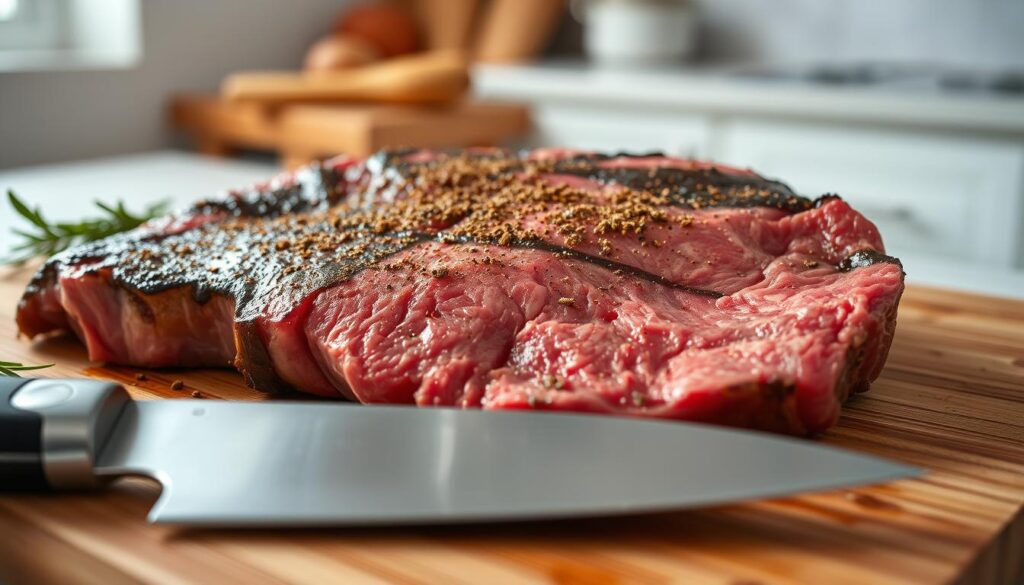
International Inspirations
The Denver steak is also popular worldwide. French cooking uses butters and wine to enhance the steak’s taste. Latin American dishes add a zesty flavor with chimichurri or mole sauces.
Asian marinades with soy, ginger, and sesame give a savory taste. Mediterranean cooking uses olive oil, lemon, and herbs for a fresh flavor. These international styles can make your Denver steak even more exciting.
Trying these global flavors can open up new possibilities. For instance, chimichurri sauce brings a zesty kick. A soy-ginger marinade adds a deep, savory taste.
- Try a French-inspired preparation with compound butter for a rich flavor.
- Experiment with Latin American chimichurri for a fresh, herby taste.
- Use an Asian-style soy-ginger marinade for a savory, umami flavor.
- Opt for a Mediterranean preparation with olive oil, lemon, and herbs for a bright, refreshing taste.
By exploring different cuisines, you can enjoy the Denver cut steak in many ways. Whether you like bold international flavors or classic American dishes, this steak is versatile and delicious.
Storing Leftover Denver Cut Steak
Storing leftover Denver Cut Steak right is key to keeping its flavor and tenderness. Whether you grilled, pan-seared, or slow-cooked it, knowing how to store it is important. This helps keep its quality high.
Refrigeration Best Practices
To keep your leftover steak fresh, follow these refrigeration tips. First, let the steak cool down to room temperature within two hours. This stops bacteria from growing.
Then, wrap it tightly in plastic wrap or foil, or use an airtight container. This keeps air out. Store it on the lower fridge shelves, where it’s cooler.
Cooked Denver Cut Steak can last 3 to 4 days in the fridge. Always check for spoilage signs like bad smells, slimy texture, or mold. If you see these, throw it away.
Creative Ways to Use Leftovers
Leftover Denver Cut Steak can make many tasty meals. Slice it thin for steak sandwiches or salads. Or chop it for a breakfast hash.
You can also dice it for pasta dishes or as a topping for steak tacos. For a global twist, use it in Asian-inspired stir-fries or Mexican-inspired dishes. Reheat it gently to keep it moist and tender.
- Slice the steak thinly against the grain for maximum tenderness.
- Use leftover steak in salads, adding your favorite greens, vegetables, and dressings.
- Incorporate chopped steak into omelets or frittatas for a protein-packed breakfast.
- Add diced steak to soups or stews for an extra boost of flavor.
By storing your leftover Denver Cut Steak right and getting creative, you can enjoy it in many meals. This makes your investment worth it.
Nutritional Benefits of Denver Cut Steak
Denver cut steak is great for a healthy diet. It’s not only tasty but also packed with essential nutrients.
Protein Content and Health Benefits
Denver cut steak is a top-notch protein source. It has all the amino acids needed for muscle health and growth. A 6-ounce serving gives you about 40-45 grams of protein, helping meet your daily needs.
This steak is also rich in vitamins and minerals. It’s loaded with B vitamins, like B12, which is good for nerves and blood cells. It also has zinc for immunity, iron for blood, and phosphorus for bones.
| Nutrient | Amount per 6 oz serving | % Daily Value |
|---|---|---|
| Protein | 40-45 grams | 80-90% |
| Vitamin B12 | 2.5 mcg | 42% |
| Zinc | 4.5 mg | 30% |
| Iron | 3.5 mg | 19% |
| Phosphorus | 350 mg | 35% |
The fat in Denver cut steak includes healthy monounsaturated fats, like those in olive oil. While it should be eaten in moderation, these fats are beneficial.
Balancing with Your Diet
Adding Denver cut steak to your diet is easy with some planning. Try to eat only 3-4 ounces at a time. This way, you get plenty of protein without too many calories.
To make meals balanced, pair Denver cut steak with other foods. Good choices include:
- Roasted vegetables like broccoli or Brussels sprouts
- Whole grains such as quinoa or brown rice
- Leafy greens like spinach or kale
By mixing these foods with Denver cut steak, you can enjoy a healthy and varied diet.
In summary, Denver cut steak is a nutritious choice for your meals. Its high protein and nutrient content make it a great part of a balanced diet.
Conclusion
As you finish this guide, you now know a lot about the Denver cut steak. You’ve learned about its unique features and how to cook it well.
The Essentials Revisited
Important points include picking the right cut, using the right tools, and learning various cooking methods. These steps help bring out the best in your denver steak.
Exploring Your Culinary Creativity
Now that you know the basics, it’s time to try new things. Experiment with different seasonings, cooking techniques, and sides to make your denver cut steak stand out.
Using these skills, you’ll keep getting better at cooking denver cut steak. Each time, it will be more fun and tasty.
FAQ
What is a Denver cut steak?
Where does the Denver cut steak come from on the cow?
How do I select a high-quality Denver cut steak?
What are the different grades of beef, and how do they affect the Denver cut steak?
How should I store leftover Denver cut steak?
Can I marinate a Denver cut steak, and if so, for how long?
What are some recommended cooking methods for Denver cut steak?
How do I achieve the perfect doneness for my Denver cut steak?
Why is resting important after cooking a Denver cut steak?
How do I slice a Denver cut steak for optimal tenderness?
What are some good side dishes and wine pairings for Denver cut steak?
Can Denver cut steak be used in different cuisines?
For more cooking tips, stay connected with us. We also recommend the cookbook Skinnytaste Simple: Easy, Healthy Recipes with 7 Ingredients or Fewer
For more Recipes about Steak ?
Did You try our recipe ?
There are no reviews yet. Be the first one to write one.
